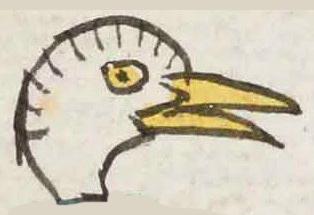aztatl (Mdz21v)
This element of a white heron or egret (aztatl) has been carved from the compound glyph for the place name, Aztaquemeca. The white bird, called an aztatl) (heron or egret), is shown here as just the head of the bird, in a profile view, looking to our right. Its yellow beak is slightly open, as is its eye.
Stephanie Wood
The aztatl is prolific across pictorial manuscripts, as can be seen in Mexico's Gran Diccionario Nahuatl, http://www.gdn.unam.mx/diccionario/aztatl/10240. From the Codex Mendoza alone, it is obvious that the Nahuas prized the egret's white feathers--such as one can see in the aztaquemitl, which also appears on the compound glyph from which this element derives.
Stephanie Wood
c. 1541, but by 1553 at the latest
Stephanie Wood
ave, aves, pájaro, pájaros, pluma, plumas, animals, animales
Aztatl. This is a taxidermic example of a egret found in the Museo del Templo Mayor. Photograph by Stephanie Wood, 15 February 2023; these comments by Robert Haskett.

azta(tl), Snowy Egret, https://nahuatl.wired-humanities.org/content/aztatl
heron or egret
la garza
Stephanie Wood
Codex Mendoza, folio 21 verso, https://digital.bodleian.ox.ac.uk/objects/2fea788e-2aa2-4f08-b6d9-648c00..., image 53 of 188.
The Bodleian Libraries, University of Oxford, hold the original manuscript, the MS. Arch. Selden. A. 1. This image is published here under the UK Creative Commons, “Attribution-NonCommercial-ShareAlike 3.0 License” (CC-BY-NC-SA 3.0).




